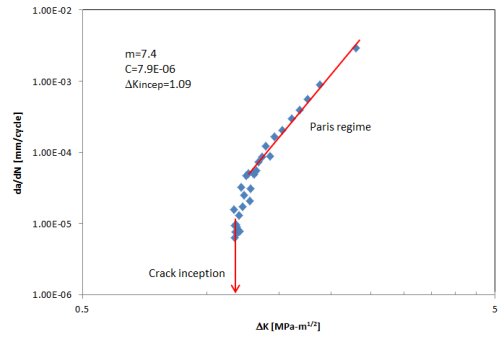Fatigue Crack Propagation

Fatigue crack propagation (FCP) analysis is a method to monitor the resistance of a material to crack inception and propagation under cyclical loading. ASTM E647 describes the methodology for measuring crack propagation in materials. An example of the typical data obtained in FCP analysis is shown above for GUR 1020 UHMWPE subjected to ionizing radiation measured at Cambridge Polymer Group. There are two principle regimes in a crack propagation plot: (1) crack inception, where the minimum load range required to start a crack to grow is determined; (2) Paris regime, where steady crack growth occurs. The x-axis shows DK, which is derived from linear elastic mechanics and is dependent on the cyclical load range (Pmax-Pmin) and the crack length (a). The expression for DK will depend on the shape of the test specimen, which is often a compact tensile geometry. The y-axis shows the crack growth as a function of number of fatigue cycles. The main reportable items for FCP analysis are the DKincep, or the load conditions for crack growth to reach 1e-6 mm/cycle, and the slope and intercept of the curve in the Paris regime (m and C, respectively). With highly crosslinked UHMWPE, the DKincep tends to decrease, and the material sometimes shows a higher sensitivity to DK in the Paris regime.
Contact Cambridge Polymer Group for more information on E647 testing.
Link to Application Note on fatigue crack testing
A link to a video showing a time lapse of a growing fatigue crack in UHMWPE can be found here.